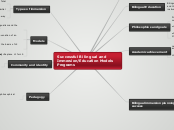Successful Bilingual and Immersion/Education Models Programs
Language immersion
Early
Middle
Late
Bilingual Education
Bilingual education is instruction in two languages and the use of those two languages as mediums of instruction for any part, or all, of the school curriculum
Philosophies and goals
Program design need sociocultural awareness to consider questions of power, culture and identity.
•Language as a resource. Goal: Bilingualism
•Minority language as a problem to overcome. Goal: Monolingualism
Academic achievement
Language minority students perform better academically in their native language
L1 schooling is a predictor of L2 achievement
Bilingual immersion planning for success
Criteria for program success in two-way immersion education:
1. A minimum of 4 to 6 years of bilingual instruction
2. The focus of instruction should be the same core academic curriculum that students in other programs experience
3. Optimal language input as well as opportunities for output should be provided
4. The target language should be used for instruction a minimum of 50% of the time
5. The program should provide an additive bilingual environment
6. Classrooms should include a balance of students from the target language and L1 backgrounds
7. Positive interactions among students should be facilitated by the use of strategies such as cooperative learning.
8. Characteristics of effective schools should be incorporated into programs, such as qualified personnel and home-school collaboration.
Types of immersion
Total
Partial
Two-way
Models
Enrichment (Additive): Aim at bilingualism and the extension of the minority language
Heritage (Additive): Aim at the rejuvenation of an indigenous language.
Maintenance (Additive): L1 is only the basis of L2 learning.
Transitional (Subtractive): Replace L1 for L2.
Community and identity
Community involvement is important for identity reconciliation and essential in heritage programs
Pedagogy
Pedagogic frameworks will come from philosophical frameworks adapted in school policy.
Equitable Interaction: Promotion of positive interactions between teacher and learners.
Targeted and Varied Teaching Techniques: respond to different learning styles
Student-Centered Teaching and Learning: encourage students to share their linguistic codes and cultural knowledge
Sharing Between Learners: Cooperative learning strategies should be encouraged.
Language through Common Task Orientation: Linguistic knowledge transfer will occur when the cooperative learning strategy is focused around a language task
